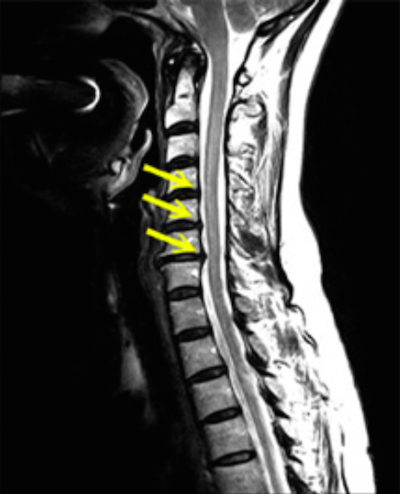Neck pain can sometimes be treated using non-surgical methods, such as physical therapy, anti-inflammatory medications and steroid injections. But some problems are serious enough to require surgery for neck pain. Herniated discs and cervical spondylotic myelopathy are two conditions that often result in the need for cervical spine / neck surgery.
Herniated nucleus pulposus, or herniated disc
A herniated nucleus pulposus is commonly known as a herniated disc, or a condition in which the soft center of a spinal disc starts bulging from an opening or crack in the tough exterior. Sometimes herniated discs in the neck may cause no symptoms or require nonsurgical treatment. Others may require surgery. Symptoms include:
- Neck pain
- Shoulder pain
- Arm pain
- Dysthesias (abnormal sensations)
- Anesthesias (numbness or lack of feeling)
The symptoms of a herniated disc may resemble carpel tunnel syndrome, rotator cuff problems or gout. An orthopedic specialist can review your symptoms and determine which condition is causing your neck pain. Diagnosis will typically include a patient exam and magnetic resonance imaging (MRI). Motor deficit — or loss of movement of a body part, such as a limb — is an indication of spinal cord compression and may require urgent orthopedic surgery. If you have a herniated disc with milder symptoms, surgery may not be needed.
Cervical Spondylotic Myelopathy
The most common type of spinal cord dysfunction in patients older than 55 years of age. Cervical spondylotic myelopathy (CSM) occurs when discs and joints in the cervical spine — or neck — degenerate. Symptoms of cervical spondylotic myelopathy include:
- Pain in the neck, subscapular area, or shoulder
- Anesthesias or paresthesias (abnormal sensations or numbness) in the upper extremities, or arms
- Sensory changes in the lower extremities, or legs
- Motor weakness in the upper or lower extremities
- Difficulty with walking or gate
The first sign of CSM is often a spastic gait, followed by numbness in the upper arms and loss of fine motor control in the hands. To improve the neurologic outcome, doctors often recommend surgery early — typically within one year of the appearance of symptoms. Early surgery can help avoid permanent problems resulting from CSM.
Other conditions, such as spinal stenosis or cervical spondylosis without myelopathy, may not require surgery. If you’re wondering if you need surgery for neck pain that you’re experiencing, make an appointment with an orthopedic specialist to determine an appropriate course of treatment.
To learn more about the cervical spine anatomy, read this blog.
If you’re going to have spinal surgery, there are steps you can take to be prepared for a successful procedure and recovery.

